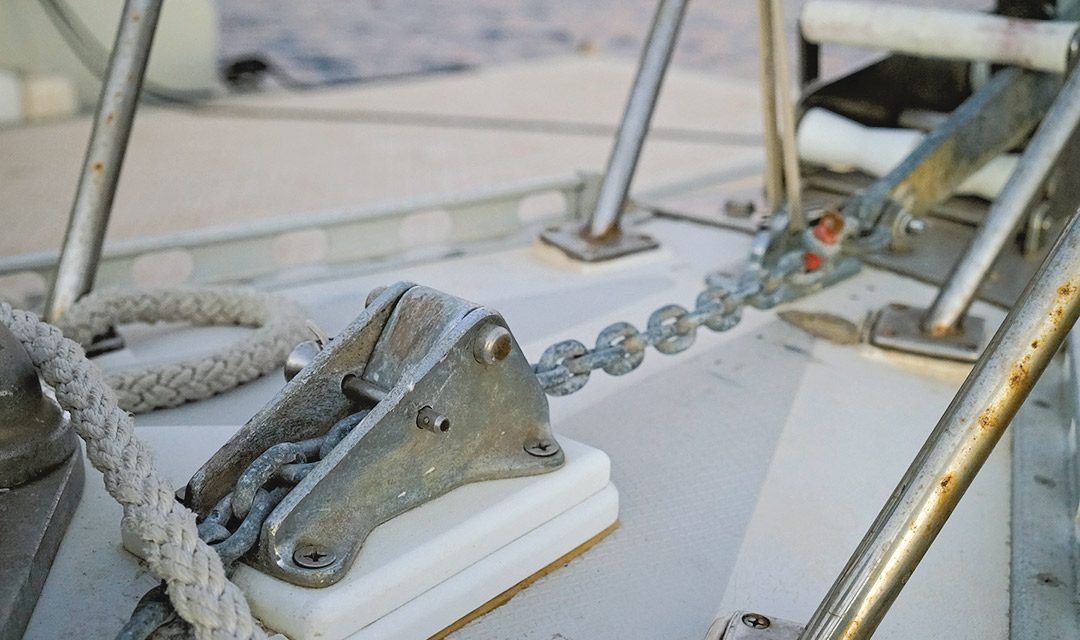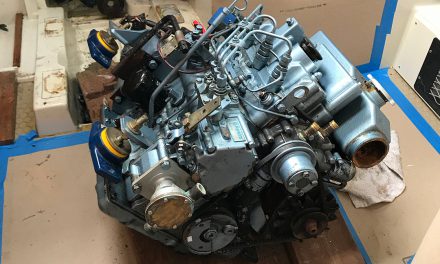A pawl, aka chain stopper, can take the strain when you windlass won’t.
Issue 138: May/June 2021
Once, when I was working for a yachting magazine, we received an anguished letter from a cruising sailor. He and his wife had nearly lost their lives anchored off a lee shore aboard their Hans Christian 38.
He wrote that it was blowing about 50 knots and seas were breaking heavily in 50 feet of water. A reef lay dangerously close aft. The couple had decided it was time to weigh anchor and get out to sea.
But when he tried to raise the 45-pound anchor to motor out of there, the all-chain rode just kept flying off the gypsy every time the bow rose on a wave, allowing even more chain to run out before it caught again. The boat was effectively pinned in place by the anchor, and the threatening reef astern kept getting closer.
Eventually, in appalling conditions and soaked by waves sweeping over the bow, the husband managed to sever the chain with bolt cutters and power to safety offshore. The question he asked in his letter was, why? Why did the chain keep slipping? What went wrong?
Well, the first thing that went wrong was allowing himself to be caught on a lee shore with no shelter from the seaward side. He should have known when he dropped the hook that if the wind came up strong from the unprotected side, he would be in trouble. He should have kept a full-time anchor watch and been prepared to hightail it on short notice.
But it was nighttime when the wind shifted and started blowing onshore, and so he procrastinated, putting off any action until the situation became desperate. It was a good thing that they carried the huge bolt cutters needed to cut the chain; freeing the boat from the anchor had become imperative to save the boat and her crew.
Second, the letter writer shouldn’t have expected the windlass to take the strain of a heavy boat plunging wildly in rough seas, and on top of that to pull her forward to the anchor. Most anchor chains contact only a quarter of the circumference of most windlass gypsies, and windlasses are designed to take little more than the weight of the anchor and chain. Being asked to hold the boat in 50 knots and breaking waves, this chain and windlass behaved exactly as they should have been expected to—poorly and dangerously.
The simplest solution to this problem is a chain pawl, also known as a chain stopper. These are designed to accept the enormous strain that an anchor rode can impart.
I remember Eric Hiscock describing, in one of his splendid books, a rudimentary stopper built into the bow roller of Wanderer III. It was no more than a hinged steel flap that bore upon the line where it passed over the roller. Its job was to act as a kind of one-way valve, allowing the rode to come inboard but not fly out again. To allow the line to run out, the stopper just needed to be flipped over.
These days, chain stoppers are manufactured and sold in chandleries. They are available for all rode sizes (all boat sizes) and should be heavily bolted down to a hardened part of the foredeck and oriented in-line with the path of the rode between the bow roller and the windlass.
The additional bonus of a chain stopper is that on a boat of 30 feet or less, it can make a windlass unnecessary. By allowing the rode to go in only one direction, all the sailor has to do is wait for the rode to go slack, pull in the slack, let the stopper take the strain—such as when the bow is pitching—and then pull again when the slack returns. (A chain stopper will also work with a rope anchor rode in a pinch, but repeated use will damage the line.)
With the help of a chain stopper, a reasonably fit person should be able to handle a 35-pound anchor with 5/16-inch chain without the help of a winch, and without crushing any vertebrae.
John Vigor is a retired newspaper columnist and the author of 12 books about small sailboats, including Small Boat to Freedom. He lives in Bellingham, Washington. johnvigor.com
Thank you to Sailrite Enterprises, Inc., for providing free access to back issues of Good Old Boat through intellectual property rights. Sailrite.com






